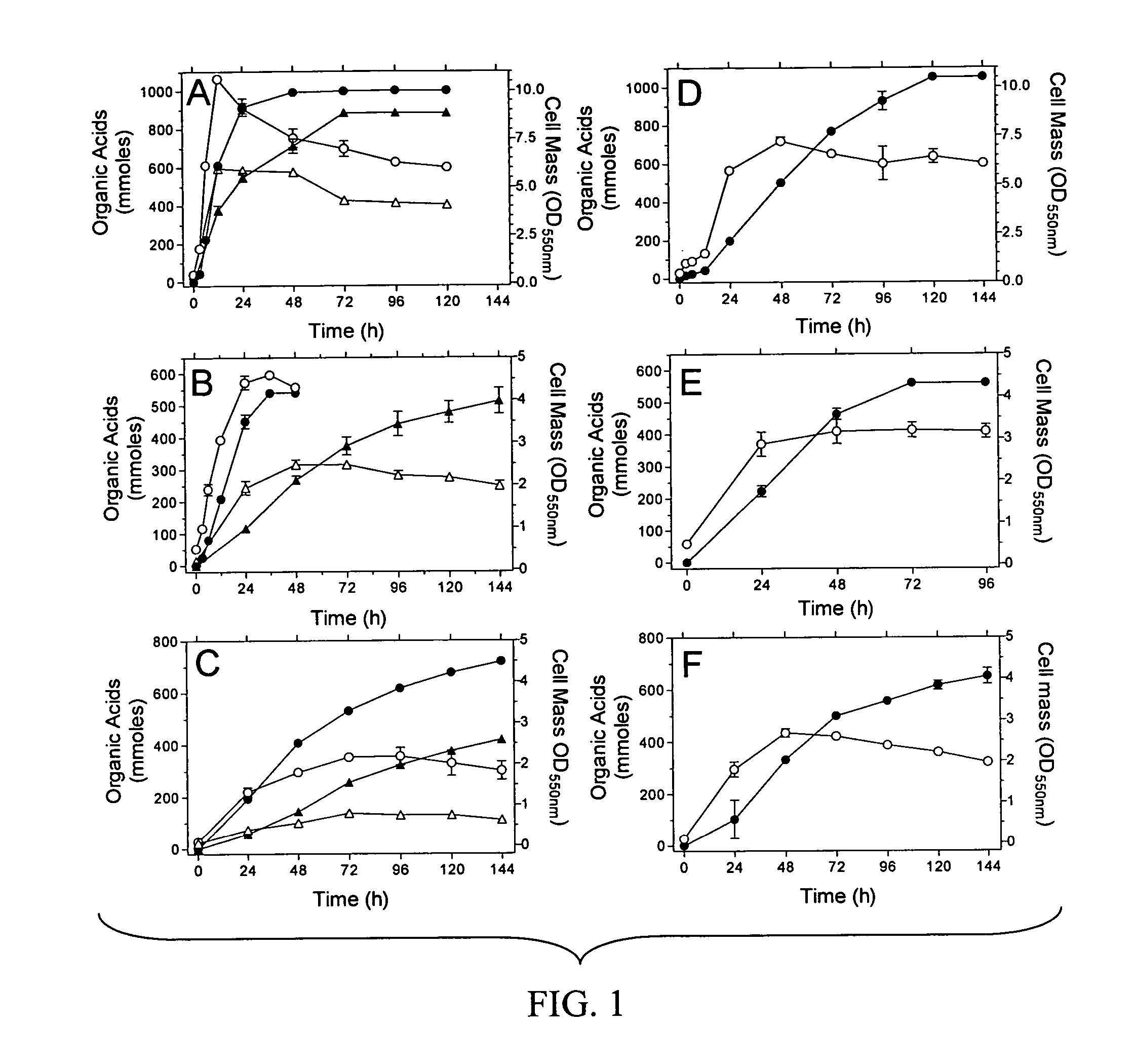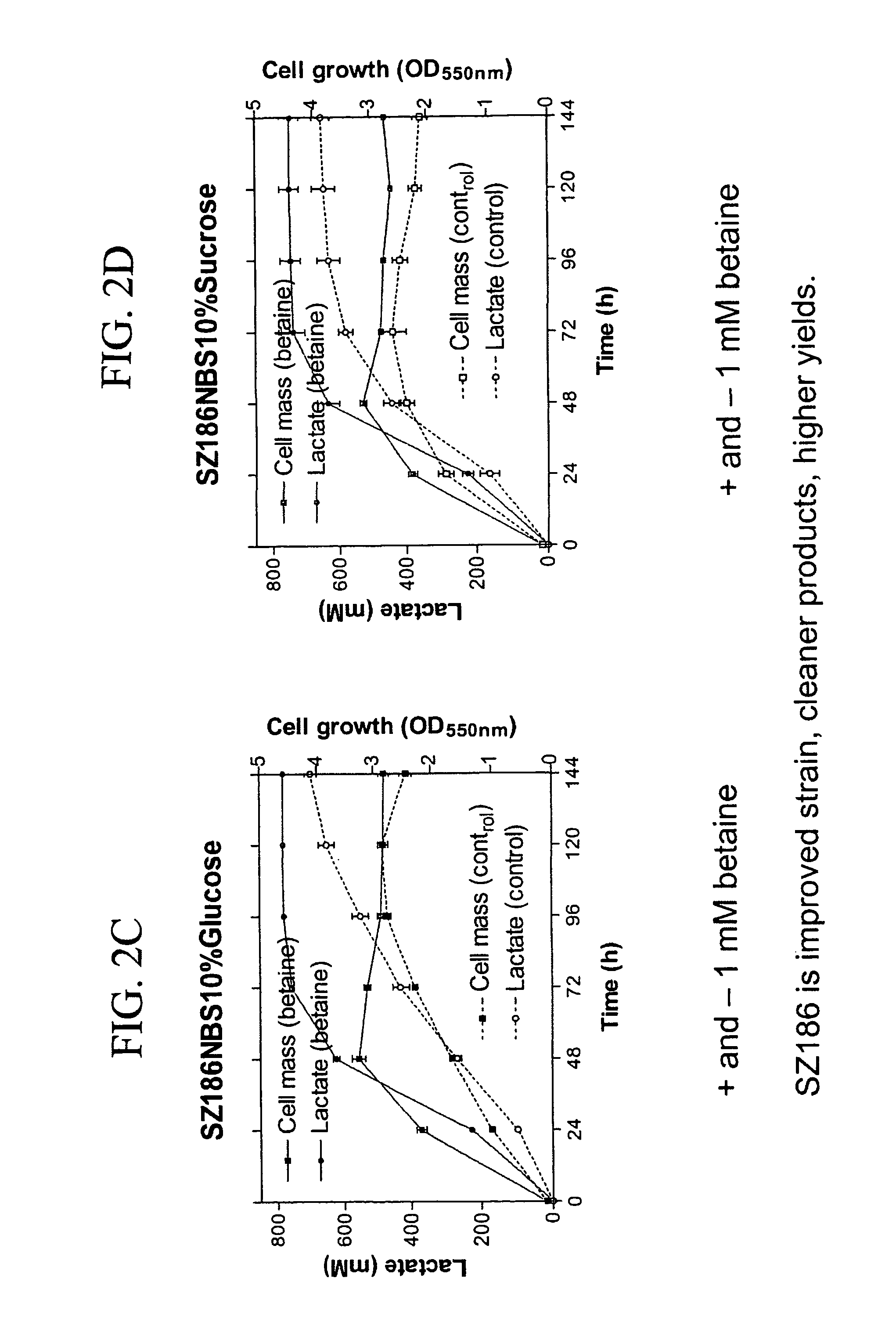Materials and methods for efficient lactic acid production
a technology of lactic acid and materials, applied in the field of materials and methods for efficient lactic acid production, can solve the problems of high inefficiency of fermentation methods for producing lactic acid, difficult purification, and rare optically pure product, and achieve the effect of increasing the supply of lactic acid and enhancing the production
- Summary
- Abstract
- Description
- Claims
- Application Information
AI Technical Summary
Benefits of technology
Problems solved by technology
Method used
Image
Examples
example 1
Preparation and Analysis of E. coli Strains SZ132 and SZ186
[0145]E. coli strains used in this Example are listed in Table 1. Strain SZ63 is a derivative of E. coli K-12 (ATCC 27325). KO11 (ATCC 55124) is a derivative of E. coli B (ATCC 11303) that contains the Zymomonas mobilis ethanol production genes integrated into the pflB gene.
TABLE 1E. coli strainsStrainsRelevant CharacteristicsSourcesDH5αΔlacZ M15 recAInvitrogenS17-1thi pro recA hsdR RP4-2-tet::MuSimon et al. 1983aphA::Tn7 λpirTC20ΔadhE::FRT-tet-FRTZhou et al. 2003SZ31W3110, Δ(focA-pflB)::FRT-kan-FRTZhou et al. 2003SZ61W3110, ΔackA::FRT-tet-FRTZhou et al. 2003SZ63W3110, ΔfocA-pflB::FRT ΔfrdZhou et al. 2003ΔadhE::FRT ΔackA::FRTNC3E. coli B / r, hsdRDien et al. 2001KO11pflB::Z. mobilis pdc adhB cat, ΔfrdOhta et al. 1991LY52KO11, frdA::K oxytoca casAB,This examplelacY::E. chrysanthemi celYSZ132LY52, Δ(focA-pdc-adhB-pflB)This exampleΔadhE::FRTΔackA::FRT, ΔcasASZ186SZ132, ΔK. oxytoca casABThis exampleΔE. chrysanthemi celY
[0146] C...
example 2
Preparation of E. coli Strain SZ194
[0160] Strains and plasmids used in the preparation of Strain SZ194 are listed in Table 3. Cultures were grown at 37° C. in modified Luria broth (per liter: 10 g Difco tryptone, 5 g Difco yeast extract, 5 g sodium chloride) (Miller, J. H. 1992 A Short Course in Bacterial Genetics: A Laboratory Manual and Handbook for Escherichia coli and Related Bacteria. Cold Spring Harbor Press, Cold Spring Harbor, N.Y.) or in NBS mineral salts medium (Causey, T. B. et al. 2004, “Engineering Escherichia coli for efficient conversion of glucose to pyruvate,”Proc. Natl. Acad. Sci. USA 101:2235-2240) supplemented with 1 mM betaine and 2%-14% (w / v) sugar (glucose or sucrose). When needed, ampicillin (50 mg / L) and kanamycin (50 mg / L) were used for strain constructions.
TABLE 3E. coli Strains and PlasmidsRelevant CharacteristicsSourcesStrainsSZ132Δ(focA-Z. mobilis pdc-adhB-pflB)Zhou et al. (2005)adhE::FRT Δack::FRT Δfrd, frdA::E. chrysanthemicelY lacY::K. oxytoca cas...
example 3
Materials and Methods
Strains, Plasmids, Media and Growth Conditions
[0175]E. coli strains, plasmids and primers utilized in this study are listed in Table 7. Strain SZ194 was previously constructed from a derivative of E. coli B (ATCC 11303) and served as a starting point for constructions (see Example 2 and Zhou et al., 2006). During strain constructions, cultures were grown aerobically at 30C., 37° C., or 39° C. in Luria broth (per liter: 10 g Difco tryptone, 5 g Difco yeast extract and 5 g sodium chloride) (Miller 1992) containing 2% (w / v) glucose or arabinose. Ampicillin (50 mg / L), tetracycline (12.5 or 6.25 mg / L), or kanamycin (25 or 50 mg / L) were added as needed. For fermentation tests, strains were grown without antibiotics at 37° C. in NBS mineral salts medium (Causey et al., 2004) supplemented with 1 mM betaine and 2-12% (w / v) glucose. MOPS buffer (100 mM, pH 7.4) was added to solid and liquid medium under conditions which lacked pH control (plates, tubes, shaken flasks)...
PUM
| Property | Measurement | Unit |
|---|---|---|
| Fraction | aaaaa | aaaaa |
| Fraction | aaaaa | aaaaa |
| Fraction | aaaaa | aaaaa |
Abstract
Description
Claims
Application Information
 Login to View More
Login to View More - R&D
- Intellectual Property
- Life Sciences
- Materials
- Tech Scout
- Unparalleled Data Quality
- Higher Quality Content
- 60% Fewer Hallucinations
Browse by: Latest US Patents, China's latest patents, Technical Efficacy Thesaurus, Application Domain, Technology Topic, Popular Technical Reports.
© 2025 PatSnap. All rights reserved.Legal|Privacy policy|Modern Slavery Act Transparency Statement|Sitemap|About US| Contact US: help@patsnap.com



